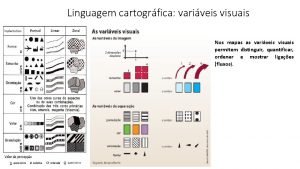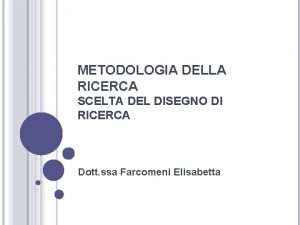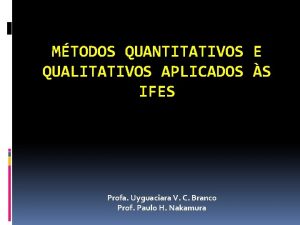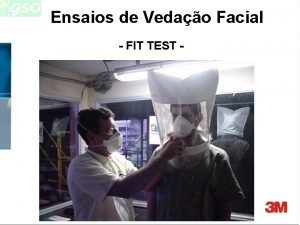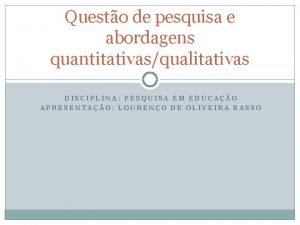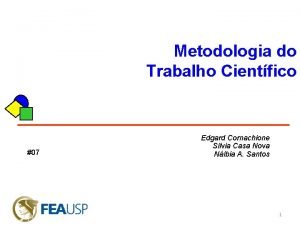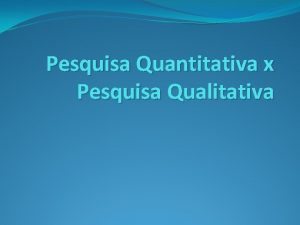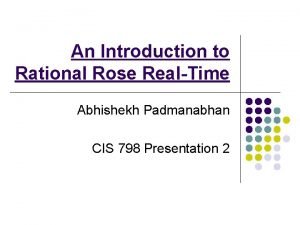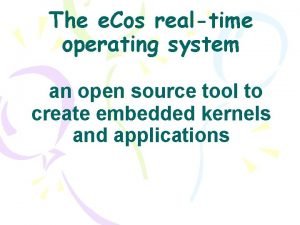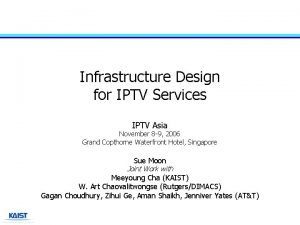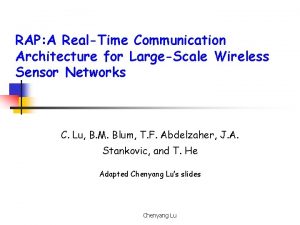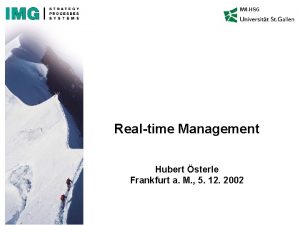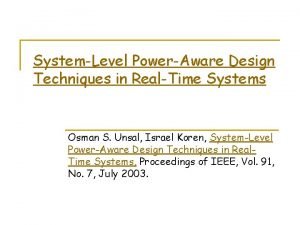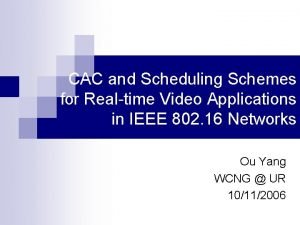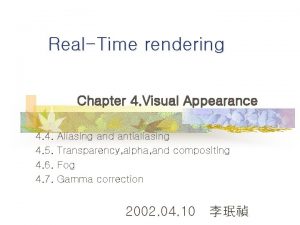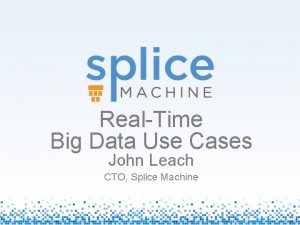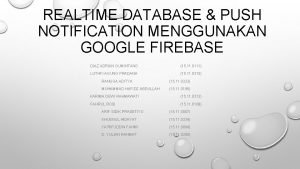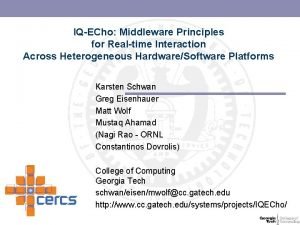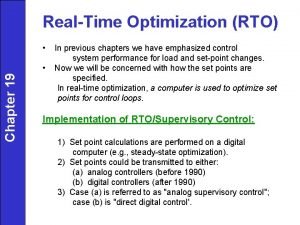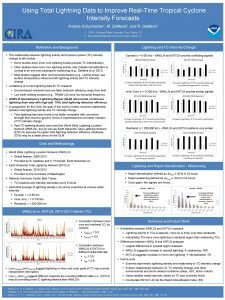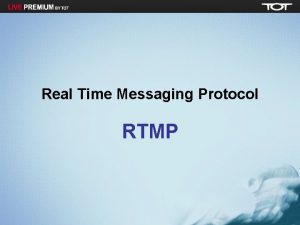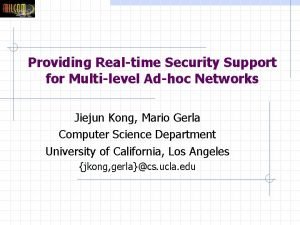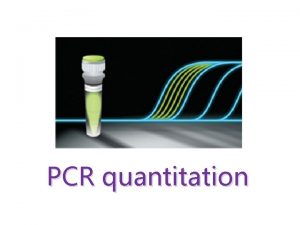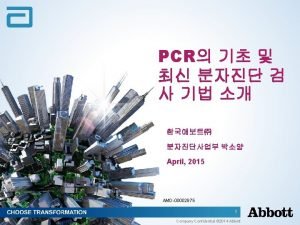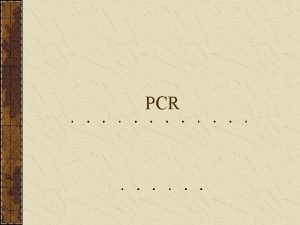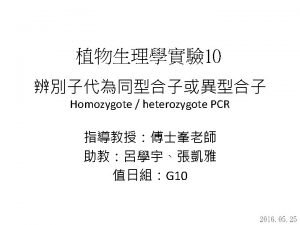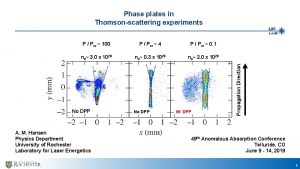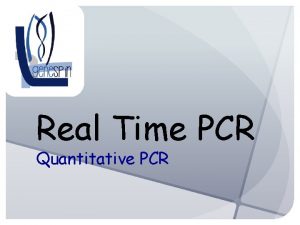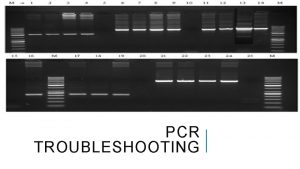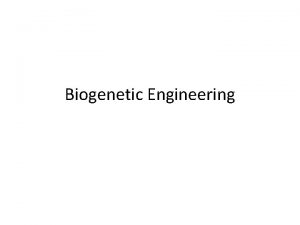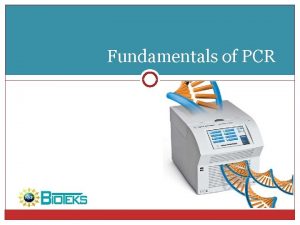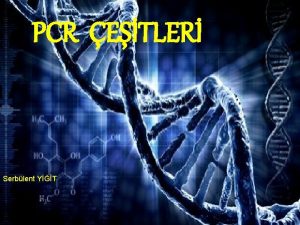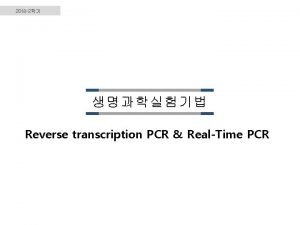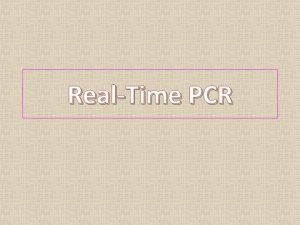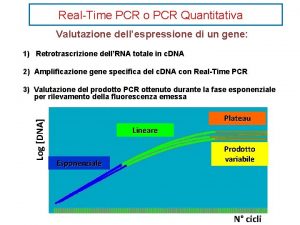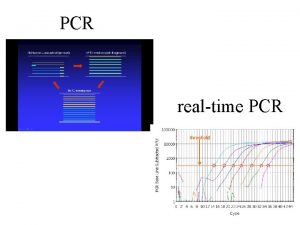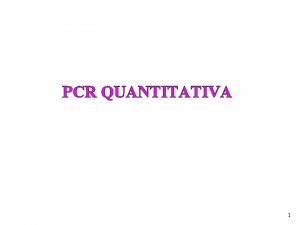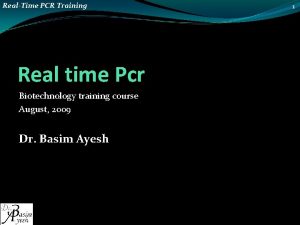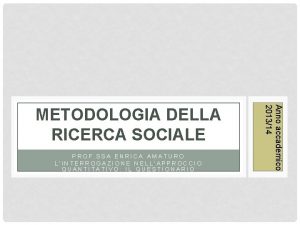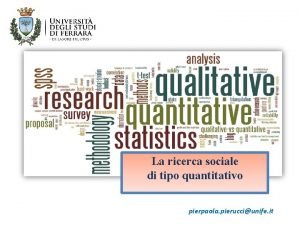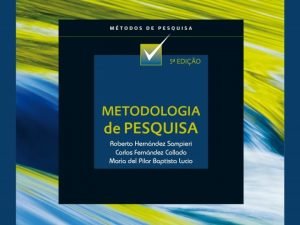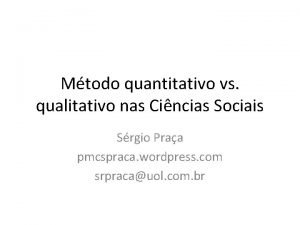PCR quantitativo What is RealTime PCR RealTime PCR






























![ΔΔCt method experiment control -[(Cttg-Ctcg)-(Cttg-Ctcg)] 2 Ex! D Ct = target gene– ref gene ΔΔCt method experiment control -[(Cttg-Ctcg)-(Cttg-Ctcg)] 2 Ex! D Ct = target gene– ref gene](https://slidetodoc.com/presentation_image_h/78af2a17db15f350bfaccc42e10e9371/image-31.jpg)





- Slides: 36

PCR quantitativo

What is Real-Time PCR? Real-Time PCR is a specialized technique that allows a PCR reaction to be visualized “in real time” as the reaction progresses. This enables researchers to quantify the amount of DNA in the sample at the start of the reaction!

What is Real-Time PCR? Differences with normal PCR? • 20 ul PCR reactions • SYBR Green or probes § § 94°C 4 min 94°C 15 sec 40 x 61°C 30 sec 72°C 30 sec

What is Real-Time PCR used for? Real-Time PCR has become a cornerstone of molecular biology: • Gene expression analysis – Medical research – Drug research • Disease diagnosis – Viral quantification • Food testing – Percent GMO food • Transgenic research – Gene copy number

What is Real-Time PCR? Taq polymerase can only synthesize DNA, so how do we study gene expression (RNA) using q. PCR? Reverse transcription RNA -> DNA (c. DNA)

What’s Wrong With Agarose Gels? Low sensitivity § Low resolution § Non-automated § Size-based discrimination only § Results are not expressed as numbers based on personal evaluation § Ethidium bromide staining is not very quantitative § End point analysis §

Endpoint analysis Different concentrations give similar endpoint results!

Imagining Real-Time PCR …So that’s how PCR is usually presented. To understand real-time PCR, let’s imagine ourselves in a PCR reaction tube at cycle number 25…

Imagining Real-Time PCR What’s in our tube, at cycle number 25? A soup of nucleotides, primers, template, amplicons, enzyme, etc. ~1, 000 copies of the amplicon right now.

Imagining Real-Time PCR How did we get here? What was it like last cycle, 24? Almost exactly the same, except there were only 500, 000 copies of the amplicon. And the cycle before that, 23? Almost the same, but only 250, 000 copies of the amplicon. And what about cycle 22? Not a whole lot different. 125, 000 copies of the amplicon.

Imagining Real-Time PCR How did we get here? If we were to graph the amount of DNA in our tube, from the start until right now, at cycle 25, the graph would look like this:

Imagining Real-Time PCR So where are we going? What’s it going to be like after the next cycle, in cycle 26? Probably there will be 2, 000 amplicons. And cycle 27? Maybe 4, 000 amplicons. And at cycle 200? In theory, there would be 1, 000, 000, 000, 000, 000, 000 amplicons… ?

Imagining Real-Time PCR If we plot the amount of DNA in our tube going forward from cycle 25, we see that it actually looks like this: So where are we going? • • Realistically, at the chain reaction progresses, it gets exponentially harder to find primers, and nucleotides. And the polymerase is wearing out. So exponential growth does not go on forever!

Imagining Real-Time PCR Measuring Quantities How can all this be used to measure DNA quantities? ? What if YOU started with FOUR times as much DNA template as I did? I have 1, 000 copies at cycle 25. You have 4, 000 copies! So… You had 2, 000 copies at cycle 24. And… You had 1, 000 copies at cycle 23.

Imagining Real-Time PCR Measuring Quantities So… if YOU started with FOUR times as much DNA template as I did… Then you’d reach 1, 000 copies exactly TWO cycles earlier than I would!

Imagining Real-Time PCR Measuring Quantities What if YOU started with EIGHT times LESS DNA template than I did? You’d only have 125, 000 copies right now at cycle 25… …and you’ll have 250, 000 at 26, 500, 000 at 27, and by cycle 28 you’ll have caught up with 1, 000 copies! So… you’d reach 1, 000 copies exactly THREE cycles later than I would!

The “ct value” Imagining Real-Time PCR • • The value that represents the cycle number where the amplification curve crosses an arbitrary threshold. Ct values are directly related to the starting quantity of DNA, by way of the formula: Quantity = 2^Ct Ct Values: Measuring Quantities 23 Threshold 25 28

threshold Ct

Imagining Real-Time PCR Measuring Quantities There’s a DIRECT relationship between the starting amount of DNA, and the cycle number that you’ll reach an arbitrary number of DNA copies (Ct value). DNA amount = 2 ^ Cycle Number


How do We Measure DNA in a PCR Reaction? We use reagents that fluoresce in the presence of amplified DNA! Ex. SYBR Green dye They bind to double-stranded DNA and emit light when illuminated with a specific wavelength.

• ds. DNA intercalating dye • Unspecific (optimization) • cheap SYBRgreen How do We Measure DNA in a PCR Reaction? 5’ 3’ Extension 3’ 5’ ID 5’ Taq ID ID Taq 5’ ID 3’ Apply Excitation Wavelength l l 3’ 5’ l ID ID ID Taq l ID l Taq 5’ ID 5’ 3’

Melting curve – Test the presence of unspecific amplification, contamination, primer dimers, . .

Taq. Man probes • Sequence-specific • Doesn´t need much optimization • More expensive

What Type of Instruments are used with Real. Time PCR? Real-time PCR instruments consist of TWO main components: • Thermal Cycler (PCR machine) • Optical Module (to detect fluorescence in the tubes during the run)

What Type of Instruments are used with Real. Time PCR? • Adequate, optical plates Ø 96/384 wells Ø Standard/fast • Optical sealing adhesive

Quantification and Normalization

Quantification and Normalization • First basic underlying principle: every cycle there is a doubling of product. • Second basic principle: we do not need to know exact quantities of DNA, instead we will only deal with relative quantities. • Third basic principle: we have to have not only a “target” gene but also a “normalizer” gene. • Key formula: Quantity = 2 ^ (Cta – Ctb)

Standard Curve Quantification and Normalization Prepare a 2 -fold serial dilution of a DNA sample: Recomendation: add always a standard curve in every run

Quantification and Normalization “normalizer” gene • Knowing the amount of m. RNA in one sample from one specific gene does not tell us much. . • You need to know the total amount of m. RNA in your sample • You also dont know how much the m. RNA level has changed compared to other m. RNA levels • Example: m. RNA levels of a gene increase 2 x after induction It is possable that all (1) genexpression in the cell has increased (2) the induced samples contained more total m. RNA We have to compare the expression of our gene to another gene which expression is normally constant, a housekeeping gene (ex. TBP, 18 S)
![ΔΔCt method experiment control CttgCtcgCttgCtcg 2 Ex D Ct target gene ref gene ΔΔCt method experiment control -[(Cttg-Ctcg)-(Cttg-Ctcg)] 2 Ex! D Ct = target gene– ref gene](https://slidetodoc.com/presentation_image_h/78af2a17db15f350bfaccc42e10e9371/image-31.jpg)
ΔΔCt method experiment control -[(Cttg-Ctcg)-(Cttg-Ctcg)] 2 Ex! D Ct = target gene– ref gene D Ct = 9. 70 D Ct = target gene– ref gene D Ct = -1. 70 Difference = DCt-DCt = DDCt = 9. 70 -(-1. 7) = 11. 40 Fold change = 211. 40 = 2702 Always in duplicate or triplicate!

Quanto aos primers. . • Para q. PCR: Iniciadores que flanqueiam a junção exon-exon para evitar amplificação inespecífica devido à contaminação por g. DNA. • Sempre testar os primers pela 1ª vez por PCR normal em pelo menos 3 diferentes temperaturas e correr gel! Escolher a máxima temperatura em que há apenas 1 banda (e do tamanho esperado!) e a amplificação ainda é satisfatoria!

Calculando a eficiência dos primers em q. PCR Ideal: N = N 0. 2 n N = número de moléculas amplificadas N 0 = número de moléculas inicial n = Número de ciclos threshold Ct Curva padrão


E = 10^(-1/slope) E = (10^(-1/slope)-1)*100 Ex. slope = -3, 81 Eficiência = (10^(-1/-3. 81)-1)*100 = 83% Ideal: eficiência >95% 35

Results? 2. 5 Good experimental design Optimal primers Good RNA Good c. DNA Relative gene expression log 10 of relative gene expresion 2 1. 5 Adequate nr of samples Adequate nr of replicates 1 0. 5 0 Good STATISTICS -0. 5 -1 -1. 5 Treatment Gene A B C D E F G UCE Value 1. 828745739 2. 04179718 0. 666738198 1. 999855536 - 0. 450673805 0. 509327854 - 1. 195371388 0 Call up regulated unaffected down regulated control gene
 Mapa qualitativo e quantitativo
Mapa qualitativo e quantitativo Qualitativo e quantitativo
Qualitativo e quantitativo Quasi esperimento
Quasi esperimento Enfoque qualitativo e quantitativo
Enfoque qualitativo e quantitativo Fit test quantitativo
Fit test quantitativo Qualitativo ou quantitativo
Qualitativo ou quantitativo Enfoque qualitativo e quantitativo
Enfoque qualitativo e quantitativo Dados qualitativos e quantitativos
Dados qualitativos e quantitativos Rational rose realtime
Rational rose realtime Cos operating system
Cos operating system Iptv infrastructure design
Iptv infrastructure design Simple online and realtime tracking
Simple online and realtime tracking Ecurisa
Ecurisa Js code
Js code Realtime mobile communication
Realtime mobile communication Rendering realtime compositing
Rendering realtime compositing Realtime it
Realtime it Realtime aps software
Realtime aps software Frankfurt realtime
Frankfurt realtime Realtime
Realtime Cac realtime
Cac realtime Visual rendering
Visual rendering Forrester wave real time interaction management
Forrester wave real time interaction management Realtime iep
Realtime iep Ams realtime weather maps central
Ams realtime weather maps central Realtime big data
Realtime big data Realtime it
Realtime it Firebase realtime notification
Firebase realtime notification Realtime interaction
Realtime interaction Rto real time optimization
Rto real time optimization Realtime forex
Realtime forex Lightning realtime
Lightning realtime Real time characteristics of embedded operating systems
Real time characteristics of embedded operating systems Flash streaming server
Flash streaming server Ad hoc realtime
Ad hoc realtime Realtime etl
Realtime etl Realtime it
Realtime it
